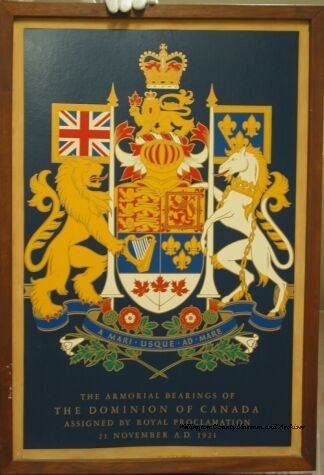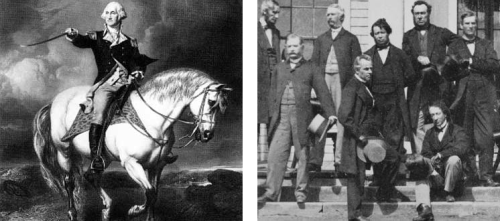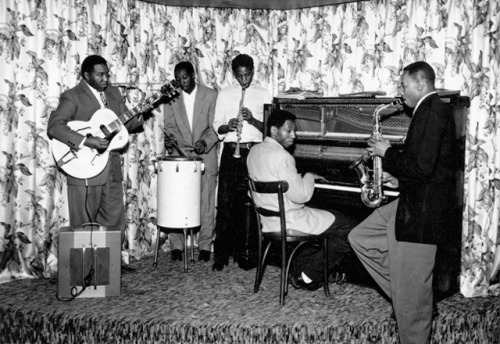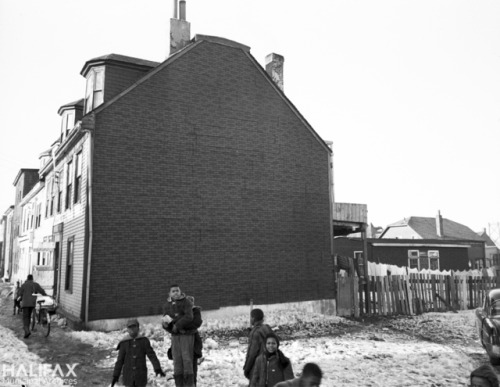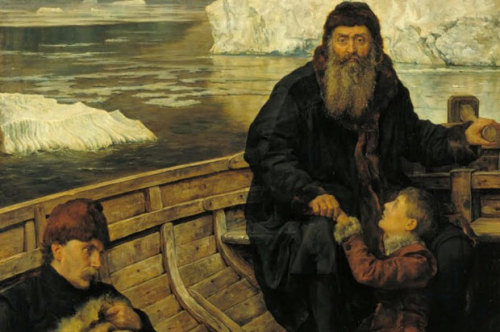#canadian history
Canada Building, New York World’s Fair
Source:NY Public Library
Canadian pavilion at the fair. I love it!
Post link
July 1, 1867 - Canadian Independence Day
“The autonomous Dominion of Canada, a confederation of Nova Scotia, New Brunswick, and the future provinces of Ontario and Quebec, is officially recognized by Great Britain with the passage of the British North America Act. July 1 becomes known as Canada Day.
During the 19th century, colonial dependence gave way to increasing autonomy for a growing Canada. In 1841, Upper and Lower Canada—now known as Ontario and Quebec—were made a single province by the Act of Union. In the 1860s, a movement for a greater Canadian federation grew out of the need for a common defense, the desire for a national railroad system, and the necessity of finding a solution to the problem of French and British conflict. When the Maritime provinces, which sought union among themselves, called a conference in 1864, delegates from the other provinces of Canada attended. Later in the year, another conference was held in Quebec, and in 1866 Canadian representatives traveled to London to meet with the British government.
On July 1, 1867, with passage of the British North America Act, the Dominion of Canada was officially established as a self-governing entity within the British Empire. Two years later, Canada acquired the vast possessions of the Hudson’s Bay Company, and within a decade the provinces of Manitoba and Prince Edward Island had joined the Canadian federation. In 1885, the Canadian Pacific Railway was completed, making mass settlement across the vast territory of Canada possible.”
This week in History:
June 28, 1969 - The Stonewall Riots begin
June 29, 1613 - The Globe Theatre burns down
June 30, 1859 - Charles Blondin crosses Niagara Falls on tightrope
July 1, 1863 - The Battle of Gettysburg begins
July 2, 1964 - President Johnson signs Civil Rights Act
July 3, 1775 - Washington formally takes command of Continental Army
July 4, 1776 - Continental Congress adopts Declaration of Independence
This print depicting the Canadian Coat of Arms can be found in the online collection of the Wellington County Museum & Archives.
Post link
Compare & Contrast
On the left is a painting of George Washington, the first President of the United States, riding a majestic white stallion.
On the right is a photo of Sir John A. Macdonald, first Prime Minister of Canada, hungover and sitting on the steps of Government House the morning following the Charlottetown Conference, which set Confederation in motion, surrounded by other hungover delegates.
US: 0, Canada: 1
Post link
By: Shawkay Ottmann
Indigenous veteran Clarence Silver as soon as stated, “When I served overseas I was a Canadian. When I came home I was an Indian.”[1] These two strains illustrate the Indigenous expertise in the Second World War. Indigenous troopers fought in all major battles Canada participated in, including D-Day, aspect by aspect with non-Indigenous soldiers. The distinction was in the state of affairs Indigenous soldiers came from and returned.
D-Day, 6 June 1944, was a pivotal day in the Second World War. When the Allied forces landed on five seashores in Normandy it signaled the beginning of the finish of Nazi Germany. Likewise, the conflict was pivotal for Indigenous peoples in the battle for Indigenous rights and equality. In each conditions, these experiences turned decisive influences in the course of history.
Reportedly there were three,090 Canadian Indigenous individuals in the Second World War. This quantity solely reflects a portion of those who served. Métis, Inuit, and Non-Status First Nations individuals have been excluded from the rely, along with Indigenous individuals who served in American Forces.[2] Amongst those who served and have been present on D-Day have been Francis William Godon, a Métis man in the Royal Winnipeg Rifles, George Horse from Thunderchild First Nation who joined the Elite Sapper Battalion, and Tom Naphtahli “Little Chief” Settee with The Regina Rifle Regiment.

Francis Godon (on right) with two of his buddies at Shilo, Manitoba, simply earlier than going abroad, 1943. Picture from Francis Godon by way of The Memory Challenge.
The primary barrier Indigenous peoples faced was at enlistment. Indigenous peoples primarily served in the infantry, both on account of the quantity of manpower the infantry required and the entrance restrictions many Indigenous individuals could not cross in other branches of the army. Each the air pressure and the navy initially required enlistees to be white.[3] Additionally, meeting the instructional normal was a challenge for many Indigenous individuals. In Godon’s group, the white faculty wouldn’t admit Indigenous youngsters, and so Godon was rejected from the army 3 times earlier than he discovered a place in the army kitchens and ultimately labored his approach into the infantry.[4] It was only after making it into the infantry that the Indigenous expertise was just like the non-Indigenous expertise. Certainly, becoming a member of the army provided new freedoms to Indigenous peoples, most noticeably from the rampant discrimination confronted in Canadian society.
As such, Godon and Horse have been like many Canadian soldiers who didn’t see action previous to D-Day. Godon educated on the Isle of Wight earlier than boarding the ship taking him to Normandy, and Horse educated off the coast of Scotland. Each men knew that they have been coaching for an invasion, however the particulars beyond that have been minimal. Godon stated, “we knew we were going to the invasion, but we didn’t know where.”[5] The secrecy that surrounded the assault was properly guarded to take care of the factor of surprise. Horse stated, “The Germans thought we were going to cross at Dover to Calais but we landed… where they least expected us.”[6]
On D-Day over 155,000 British, American, and Canadian troops crossed the English Channel. On the ground, the 3rd Canadian Infantry Division and the 2nd Canadian Armoured Brigade have been tasked with taking Juno Seashore. 14,000 Canadians landed on the seashore that day.[7] When the time got here, the males have been loaded onto ships and taken across the English Channel. Godon recalled a commanding officer saying, “you boys now, I guess you know what you’re getting into. Well, we’ve been waiting for this, we trained for this… I’m going to tell you something that’s not very good… most of you guys won’t be coming home.”[8] The officer’s warning proved truthful. During the Battle of Normandy, Canadians have been to endure the highest casualties in the British Military Group, 359 soldiers dying on D-Day alone, 33 of the 359 Indigenous.[9]
All three soldiers recall men falling on the seashore. Godon described making the seashore after leaping off the touchdown craft, operating for his life, and crawling off the seashore. He said, “So you had to keep going. Which was a hard thing to do because the beach was something like ketchup…That’s how blood red the beach was.”[10] Likewise, Sofa recalled, “I don’t know how I ever made it. Guys were dropping here and there; we kept running.”[11] In what was a very widespread expertise, the seashore was a battlefield that required velocity and resulted in the deaths of many. In this occasion, the sacrifice paid off. D-Day was finally successful. Settee stated, “Finally we got into town [Courseulles-sur-Mer] and started street fighting… We held that town there. We held it.”[12] By opening a further front, D-Day gave the western Allies the foothold they wanted to liberate France and finish the conflict in Europe on 8 Might 1945.

Tommy Prince (left), Canada’s most highly adorned First Nations soldier, and Tom Settee pose collectively during training. Image from Tom Sofa by way of The Memory Undertaking.
Like when enlisting, Indigenous veterans confronted distinctive challenges upon returning to Canada. Indigenous peoples weren’t Canadian citizens however wards of the state till 1960. The Department of Indian Affairs was tasked with caring for Indigenous peoples with the final objective to “do away with the tribal system and assimilate the Indian people in all respects with the inhabitants of the Dominion…”[13] The objective was enfranchisement, which might permit for movement off reserves and the proper to vote, however would also remove an individual’s Indian Standing and access to Treaty Rights. Whereas it was not necessary to enfranchise to hitch the army, some Indian Brokers instructed it was a requirement. Those that did enfranchise have been evicted from their communities after the conflict as they have been not Standing Indians and have been subsequently not allowed to stay on reserves. For many who didn’t enfranchise, Indigenous veterans acquired no or lesser advantages in comparability to non-Indigenous veterans. This was as a result of the undeniable fact that many Indigenous veterans’ solely access to Veteran Affairs was via Indian Affairs, who have been paternalistic and continued to see Indigenous individuals as incapable of operating their very own lives.[14] As such, it took 21 years of preventing for Godon to obtain his pension after the warfare.[15] A further battle based mostly solely on Indigenousness.
On one hand, many Indigenous veterans fell into addictions after returning to Canada. As an example, Godon turned an alcoholic until his son helped him get sober.[16]
On the other, the army additionally taught Euro-Canadian discipline and management expertise that led to the information and political group required to improve communities and stand up to the Canadian authorities. This created a surge of organizations preventing for Indigenous rights and equality, led by Second World War veterans. Indigenous veterans’ leadership additionally grew on a group degree. Settee taught morals and discipline via boxing in Prince Albert, Saskatchewan, helping many younger men off the streets by means of the sport. Certainly, the Tom Sofa Boxing Membership still exists in Prince Albert.[17]

Tom Sofa standing next to the portray he ready of Juno Seashore in 2010. Historica Canada.
Moreover, as a consequence of Indigenous involvement in the struggle, non-Indigenous help elevated. After preventing a struggle towards racism, Canadians have been discomforted by the remedy of Indigenous peoples in their own nation. Subsequently, with Indigenous management and non-Indigenous help, the government created the Particular Joint Committee of 1946-48, which would result in modifications in the Indian Act in 1951.[18]
D-Day was a pivotal day in the Second World War and the struggle towards Nazi Germany. Likewise, Indigenous participation in the conflict was pivotal in the battle for equality and rights in Canada for Indigenous peoples. Whereas D-Day was only the begin of the Battle of Normandy, the struggle was solely the start of a battle, persevering with an older warfare with the Canadian government to deal with Indigenous peoples as allies and sovereign nations as an alternative of wards, as that they had been prior to 1830.[19] Storming Juno Seashore required velocity and leaving the fallen behind however the struggle for Indigenous rights is far slower. It’s also a struggle in which stopping for the fallen is a necessity. In the strategy of reconciliation, the sacrifices will pay off, identical to the sacrifices of those that fell on Juno Seashore.
Shawkay Ottmann has a Main in History and a Minor in Style Design from Ryerson College. She is of combined heritage, her ancestors encapsulating the three I’s: Indigenous, Invader and Immigrant. She is Anishinaabe from Fishing Lake First Nation in Saskatchewan, as well as British, German, Polish and Norwegian.
Additional Reading:
Davison, Janet Frances. “We Shall Remember: Canadian Indians and the World War II” Dissertation. Trent University. 1993.
Godon, Francis William. “Veteran Stories: Francis William Godon” The Reminiscence Challenge. Accessed 15 April 2019. http://www.thememoryproject.com/stories/539:francis-william-godon/
Macdonald, John A. to L. Vankoughnet, January three 1887, Sessional Papers of the Dominion of Canada, Vol. 16, First Session of the Sixth Parliament, Session 1887 (No20B), p. 20B-37. Accessed February 2019. http://eco.canadiana.ca/view/oocihm.9_08052_20_16/502?r=0&s=1
Miller, J.R., Skyscrapers Cover the Heavens. Toronto: University of Toronto Press, 2000.
Prince Albert Day by day Herald. “Thomas Naphthali Settee”, InMemoriam.ca, 2012. Accessed Accessed 20 April 2019. http://www.inmemoriam.ca/view-announcement-292672-thomas-naphthali-settee.html
Settee, Thomas Naphtahli. “Veteran Tales: Tom Naphtahli “Little Chief” Sofa”, The Memory Challenge, Accessed 15 April 2019. http://www.thememoryproject.com/stories/2525:tom-naphtahli-little-chief-settee/
Sexsmith, Pamela. “George Horse – a veteran tells his tale”, AMMSA.com, 2003. Accessed 15 April 2019. https://ammsa.com/publications/saskatchewan-sage/george-horse-veteran-tells-his-tale
Veterans Affairs Canada. “Canada Remembers – D-Day and the Battle of Normandy”, Veterans Affairs Canada, 6 March 2019, Accessed 20 April 2019. https://www.veterans.gc.ca/eng/remembrance/history/historical-sheets/d-day
Veterans Affairs Canada. “Outstanding Accomplishments – Branching Out”, Veterans Affairs Canada. Accessed 14 February 2019, Accessed 15 April 2019. https://www.veterans.gc.ca/eng/remembrance/those-who-served/indigenous-veterans/native-soldiers/branching
Veterans Affairs Canada. “Two Decades Later”, Veterans Affairs Canada, 14 February 2019. Accessed 15 April 2019. https://www.veterans.gc.ca/eng/remembrance/those-who-served/indigenous-veterans/native-soldiers/second_response
Xavier, Jules and Stag, Shilo. “Francis William Godon 1924-2019 Métis D-Day veteran passes 75 years after harrowing experience at Juno Beach”, Government of Canada, 26 February 2019. Accessed 25 April 2019. http://www.army-armee.forces.gc.ca/en/news-publications/national-news-details-no-menu.page?doc=francis-william-godon-1924-2019-metis-d-day-veteran-passes-75-years-after-harrowing-experience-at-juno-beach/jskwaa54
Notes
[1] Janet Frances Davison, “We Shall Remember: Canadian Indians and the World War II” Dissertation. Trent University. 1993: 88. [2] Veterans Affairs Canada, “Two Decades Later”, Veterans Affairs Canada, 14 February 2019, Accessed April 15, 2019. https://www.veterans.gc.ca/eng/remembrance/those-who-served/indigenous-veterans/native-soldiers/second_response [3] Veterans Affairs Canada, “Outstanding Accomplishments – Branching Out”, Veterans Affairs Canada, Accessed 14 February 2019, Accessed 15 April 2019. https://www.veterans.gc.ca/eng/remembrance/those-who-served/indigenous-veterans/native-soldiers/branching [4] Francis William Godon, “Veteran Stories: Francis William Godon”, The Reminiscence Venture, Accessed 15 April 2019. http://www.thememoryproject.com/stories/539:francis-william-godon/ [5] Godon, “Veteran Stories: Francis William Godon” [6] Pamela Sexsmith, “George Horse – a veteran tells his tale”, AMMSA.com, 2003, Accessed 15 April 2019. https://ammsa.com/publications/saskatchewan-sage/george-horse-veteran-tells-his-tale [7]Veterans Affairs Canada, “Canada Remembers – D-Day and the Battle of Normandy”, Veterans Affairs Canada, 6 March 2019, Accessed 20 April 2019. https://www.veterans.gc.ca/eng/remembrance/history/historical-sheets/d-day [8] Godon, “Veteran Stories: Francis William Godon” [9] Veterans Affairs Canada, “Canada Remembers – D-Day and the Battle of Normandy” [10] Godon, “Veteran Stories: Francis William Godon” [11] Thomas Naphtahli Sofa, “Veteran Tales: Tom Naphtahli “Little Chief” Sofa”, The Memory Undertaking, Accessed 15 April 2019. http://www.thememoryproject.com/stories/2525:tom-naphtahli-little-chief-settee/ [12] Ibid. [13] John A. Macdonald to L. Vankoughnet, January three 1887, Sessional Papers of the Dominion of Canada, Vol. 16, First Session of the Sixth Parliament, Session 1887 (No20B), p. 20B-37 http://eco.canadiana.ca/view/oocihm.9_08052_20_16/502?r=0&s=1 [14] Davison, “We Shall Remember”, 85-6. [15] Jules Xavier and Shilo Stag, “Francis William Godon 1924-2019 Métis D-Day veteran passes 75 years after harrowing experience at Juno Beach”, Authorities of Canada, 26 February 2019, Accessed 25 April 2019. http://www.army-armee.forces.gc.ca/en/news-publications/national-news-details-no-menu.page?doc=francis-william-godon-1924-2019-metis-d-day-veteran-passes-75-years-after-harrowing-experience-at-juno-beach/jskwaa54 [16] Ibid. [17] Prince Albert Day by day Herald, “Thomas Naphthali Settee”, InMemoriam.ca, 2012, Accessed Accessed 20 April 2019. http://www.inmemoriam.ca/view-announcement-292672-thomas-naphthali-settee.html [18] Davison, “We Shall Remember”, 90-95, 110. [19] J.R. Miller, Skyscrapers Disguise the Heavens, (Toronto: University of Toronto Press, 2000), 118-119.Related
The post Indigenous Participation in D-Day and the Second World War – Active History appeared first on DWJ Tech.
“William Duncan late in life, exhibiting to friends for photographing the canvas, hammock, clock, water bottle, and accordion used by him on his voyage to Victoria, British Columbia, in 1856-57.“ Duncan was a British missionary who founded the Tsimshian communities of Metlakatla, British Columbia, and Metlakatla, Alaska. Taken by Sir Henry Solomon Wellcome, c. 1916-1917.
Source: National Archives and Records Administration.
Post link
Viola Desmond, civil rights icon, featured on Canadian currency. She is the first woman aside from the queen and first black woman to be featured on Canadian money.
Post link
OnHolocaust Remembrance Day,this twitter account is posting the names and photos (when available) of refugees turned away from America who became victims of Naziism. #NoBanNoWall #RefugeesWelcome
(Please leave this caption in place.)
The account is posting the names and photos of refugees from the ship MS St Louis, which brought 900+ Jewish refugees to Cuba in 1939. Cuba turned them away. Then the US turned them away. And then Canada made it clear they weren’t welcome. They were forced to return to Europe, and 254 passengers died before the end of the war, mostly in concentration camps.
Canada could have saved their lives. We should never forget the consequence of turning away.
Post link
Washington Jazz Band, 1930s. Jackie Washington was a singer, guitarist, pianist, born in Hamilton, Ontario, Canada on the 12th of November, 1919, and died in Hamilton on the 27th of June 2009; He received an honorary DH from McMaster University in 2003. At five he began to sing for social functions in Hamilton’s black community. Under the influence of the Mills Brothers, he and his brothers Ormsby, Harold and Doc performed 1930-8 as the Washingtons in Southern Ontario dance halls.
(Local History & Archives Hamilton)
Post link
Let’s kick off Black History Month with a mystery! Here’s a photograph from the Halifax Municipal Archives. Taken in the late 1950s or early 1960s, the location of where in Halifax this photograph was taken is unfortunately lost. What is interesting to us, however, are the children in the bottom of the photograph who really wanted to be a part of the photo.
If you recognize where this was taken or perhaps can identify someone featured in this photograph, please send an e-mail to [email protected] with the subject line “Photo 102-39-1-1401.12”.
Post link
Four boys pose for the camera with their wagon and wheelbarrow. 54 Hennessey St., Halifax, Nova Scotia, Canada. 1960s.
(Halifax Municipal Archives)
Post link
The British explorer Henry Hudson made four famous voyages to the United States and Canada, but his tireless efforts to locate the Northwest Passage ultimately provoked his crew to rebel against him. In 1610 Hudson led his ship Discovery to the frozen waters of modern-day Canada in an attempt to find a new western route to Asia. While the explorers succeeded in locating the Hudson Bay—later named in Hudson’s honor—their ship became lodged in pack ice, forcing them to spend a treacherous winter ashore.
By time the ice had finally cleared in early 1611, the men’s morale was dangerously low. Hudson wanted to continue searching for his passage, but he’d alienated his crew, many of whom believed the captain was hoarding food. Starving and desperate to return home, the crew revolted. After commandeering the ship, the sailors forced Hudson, his son and seven other men into a small boat and abandoned them in the Hudson Bay. The mutineers then steered Discovery toward England, but along the way all but eight of them succumbed to disease or were killed by natives. The fate of Hudson and his fellow castaways remains a mystery. A subsequent expedition found a small shelter that may have been built by the marooned explorers, but their bodies were never recovered.
Post link

From Graphic History Collective and Kapwang Bayan.
In south-west Alberta, the remains of marked trails and an aboriginal camp, and a tumulus where vast quantities of buffalo (American Bison) skeletons can still be found, are evidence of a custom practised by aboriginal peoples of the North American plains for nearly 6,000 years. Using their excellent knowledge of the topography and of buffalo behaviour, they killed their prey by chasing them over a precipice; the carcasses were later carved up in the camp below.
To start the hunt, ‘buffalo runners’, young men trained in animal behaviour, would entice the herd to follow them by imitating the bleating of a lost calf. As the buffalo moved closer to the drive lanes (long lines of stone cairns were built to help the hunters direct the buffalo to the cliff kill site), the hunters would circle behind and upwind of the herd and scare the animals by shouting and waving robes. As the buffalo stampeded towards the edge of the cliff, the animals in front would try to stop but the sheer weight of the herd pressing from behind would force the buffalo over the cliff.
Post link
PERIOD DRAMA ALERT: THE PORTER
PERIOD DRAMA ALERT: THE PORTER
Debuting on CBC and CBC Gem on Monday, February 21 at 9 p.m. (9:30 NT)
Inspired by real events and set in the roar of the 1920s, THE PORTER (8×60) follows the journeys of an ensemble of characters who hustle, dream, cross borders and pursue their ambitions in the fight for liberation – on and off the railways that crossed North America.
It is a gripping story of empowerment and idealism that…

agreat interview with the brilliant Anique Jordan
For me, Harris’ paintings from the ward and his northern landscapes are an entry point into questioning: who has the power to construct these official “histories”? And what are the implications of omitting, erasing or making invisible particular versions of history? What if Canadian history and art history could offer a nuanced, complex memory of people, places and moments?
Post link



